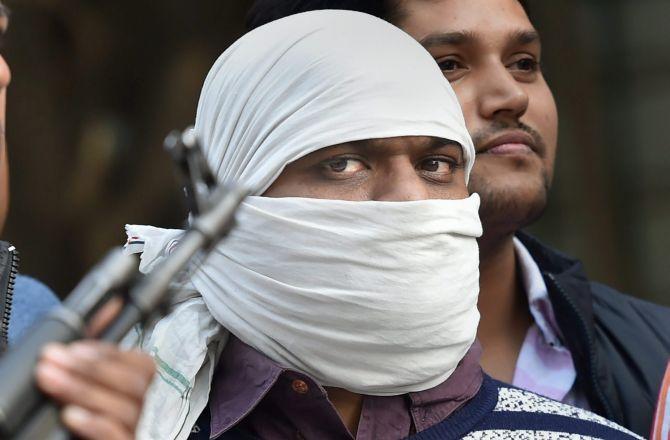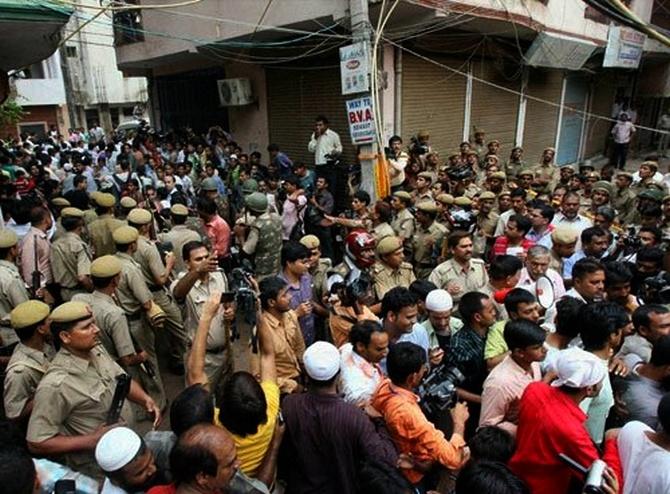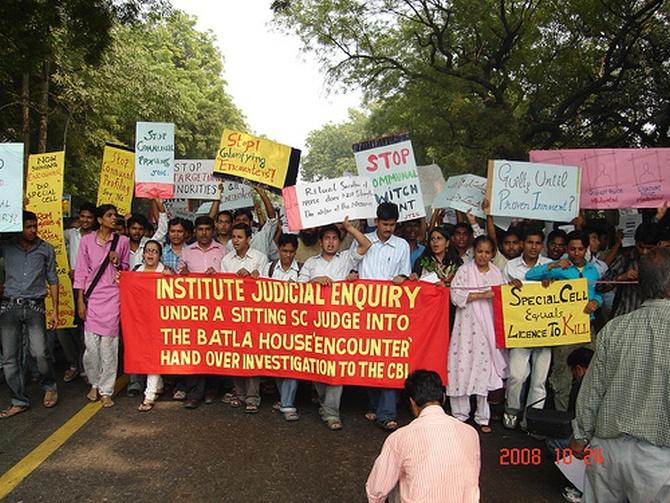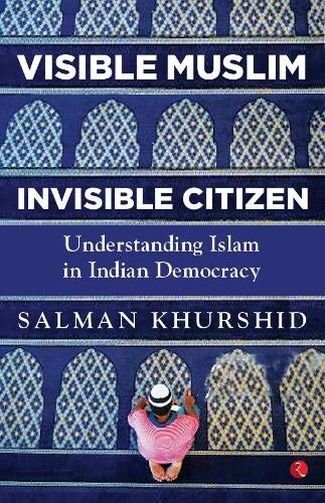''How was it that one or two boys escaped, given that there was but one narrow staircase and the exit closely guarded, as it must have been, to prevent the very escape that took place?
'How could the shots that killed Atif have been fired straight into his head, as though he had been kneeling and the shots were fired from above?
'There were no satisfactory replies.
A fascinating excerpt about the Batla House encounter, which inspired the John Abraham film, from Congress leader Salman Khurshid's Visible Muslim, Invisible Citizen.

In September 2008, the special cell of the Delhi police penetrated a Muslim-dominated neighbourhood of south Delhi for 'Operation Batla House'.
The backdrop to the encounter was a series of bomb blasts that had been executed by the Indian Mujahideen a week prior in Delhi, shocking the capital and racking up a death toll of around 30, with another hundred or so injured.
On the morning of the 19th, the police entered the Batla House area after supposedly receiving a tip that members of the terrorist group responsible for the blasts a week before were holed up in the neighbourhood.
The team of officers that went in was led by Mohan Chand Sharma, an encounter specialist.
Sub-Inspector Dharmendra entered the flat, which the police had identified as the location of the terrorists through mobile phone call records that they had cross-referenced with calls during the bombings.
Posing as a telecom agent, he confirmed the presence of the alleged terrorists in the flat.
The police team stormed the flat, leading to crossfire between the young Muslim men and the armed police.
Two of the suspects -- Atif Ameen and Mohammad Sajid -- were killed during the encounter, while two others -- Mohammad Saif and Zeeshan --were arrested; a fifth suspect -- Ariz Khan -- managed to escape during the fray.
Inspector Sharma was also hit during the shoot-out and eventually succumbed to his wounds.
Several contradicting accounts surfaced in the wake of the encounter, prompting protests by locals and conscientious groups, particularly from Jamia Millia Islamia.

Prominent members of various political parties -- the SP, the BSP and the Congress -- accused the police of staging a fake encounter and demanded a judicial inquiry into the incident.
The Delhi high court directed the NHRC to investigate the incident and submit a report, which it did, clearing the police of any charges of wrongdoing.
The report faced strong criticism in the media; activists and critics condemned the report for being rushed and based entirely on the 'official' account, having not questioned any local witnesses.
Charges were framed against the two arrested suspects, as well as the absconding one, for several offences -- murder, attempt to murder, assault on a public servant, and obstruction and tampering with evidence.
In 2013, the Saket sessions court convicted one of the accused -- Shahzad Ahmad, who was arrested later -- for the murder of Inspector Sharma and the attempted murder of two constables, along with the other charges.
Although the agencies were -- and remain -- steadfast in their belief that the young men were killed in what was a genuine encounter with Delhi police, there were questions then and there are questions now.
Let us be clear about one thing, however -- questioning the circumstances of an encounter has nothing to do with pronouncing the criminal culpability of the persons involved.
Our Constitution guarantees rights to all -- good and bad alike. If we begin to extend Constitutional guarantees only to the innocent, we would not only reverse the whole system of justice but also end up hurting many innocent people.
But strident, and at times vicious, public criticism of any objective flagging of unclear and ambiguous details of the Batla House encounter has discouraged dispassionate discussion.

Yet I felt obliged to intervene and, since I was not in the government then, I persuaded Kapil Sibal, then minister for science and technology, to visit Batla House.
Mohammed Adeeb, an MP, was my partner in the enterprise. Kapil Sibal felt some last-minute reservations, but Adeeb was unrelenting, and so we made our way to Okhla.
As we alighted from the official car, the posse of policemen guarding the entrance to the building where the firefight took place stared at us and made no gesture to come up.
Kapil Sibal felt the lack of welcome and suggested that we go to the back alley to inspect the geography. We then went up to the terrace of the neighbouring building, from where we could see the incident site.
Throughout, the people accompanying us kept up a narrative of the incident, emphatically suggesting that the official position was faked.
We came down to the street and made our way to the car, still without any gesture of hospitality from the surly policemen.
On the return journey to Lutyens' Delhi, Sibal told us that he felt shaken. We agreed to go to Digvijay Singh and accompany him to the Congress president and the PM.
We did, taking along blown-up pictures of the deceased. The Congress president, then Sonia Gandhi, was visibly distressed and asked us to seek the PM's advice.
This meeting, recalled at a public rally in Azamgarh many months later, where I spoke of her disquiet, was given a horrible spin about my having said that she cried bitterly.
The fact is that anyone would have been disturbed by the fact that young people were being drawn to unwholesome acts of violence and terrorism, and the inevitable ghastly end to their youthful but misguided lives.
My statement comes back to haunt me periodically, when some vicious self-opinionated supporter of an extremist group attempts to undermine it.

My engagement with Batla House did not end with that mournful day. A lawyer friend, having noted my public statements, arranged for me to meet a friend of his who was in the Delhi police and had been at the site of the encounter.
We met at my friend's office and had a frank conversation. The officer explained how routine surveillance of some telephone numbers in Gujarat had led them to the Batla House address.
One particular Gujarat number was traced to the vicinity and several other numbers were found linked with calls made soon after the blasts in Delhi.
One inspector was sent as a decoy, pretending to be a sim-card salesman. He knocked on the door of the top floor and, on offering wares, was told from behind the door that there was no interest.
Sub-inspector Dharmendra came down and informed his colleagues that the persons they were looking for were inside the flat.
The response team of Inspector Sharma went up and attempted to enter through the other door. The inspector got fired at from within, but his colleagues reportedly shot two of the occupants, with another man who was inside the bathroom begging not to be killed.
The police team recovered from the spot two .30 bore pistols and one AK-series rifle with two loaded magazines, containing thirty live cartridges.
I heard out the story dutifully, but then asked a few questions.
How was it that one or two boys escaped, given that there was but one narrow staircase and the exit closely guarded, as it must have been, to prevent the very escape that took place?
How could the shots that killed Atif have been fired straight into his head, as though he had been kneeling and the shots were fired from above?
Why were there other injuries, including deep bruises and ripped skin on the back of Atif's body, as though he had been dragged over a rough surface?
Why was there a photo of my interlocutor circulating, in which he was looking up towards an upper floor with a service revolver drawn for quick response?
Surely he had travelled from the Shrinivaspuri police station after getting a message about the firing incident, something that would have taken at least 15 to 20 minutes, while the encounter was over in just five?
There were no satisfactory replies.
So I ventured to ask further about the India Today cover story that had reported the surviving accused as saying that he would have planted the bombs even if he had known his mother was in the vicinity.
To this, the reply was stunning. My interlocutor said the story was false and cooked up by the correspondent who had snuck into the meeting with the senior citizens of the area.
So what exactly did he say, I asked. I was told the accused had blamed the radicalisation on the demolition of Babri Masjid. 'Our generation has been destroyed; please save the next,' the accused had pleaded.
My interlocutor claimed all this was recorded in the case diary.
I asked why he had not given this information to the electronic media to give the right perspective to the public. He said he didn't have the choice, as he was only a junior officer.

After our meeting with the Congress president, we met the PM, who was cautious and sceptical about any inquiry because of police morale.
Digvijay Singh ventured to point to his own experience as CM to suggest that this line would be a carte blanche to the police.
The PM advised us to discuss the entire matter with the LG of Delhi.
Kapil Sibal had to leave for Japan that evening, but he quickly spoke to several former judges of the Supreme Court and finally homed in on former Chief Justice Bharucha.
From the airport, he sent me terms of reference by SMS.
While he was away, I called on the LG, who was very clear that an inquiry was uncalled for, so I left it to him to share the details with Kapil Sibal on his return from Japan.
It is my understanding that they did talk and, in the process, the LG convinced Kapil Sibal that there was no point in stirring things up further.
Meanwhile, Sheila Dixit, anxious that her election barely a few weeks away would get hijacked, asked us to shelve the inquiry till after the elections. So we did. And she won her election.
However, before we could get back to it, Inspector M C Sharma, a much decorated police officer who had won seven gallantry medals, including the President of India's Medal in 2009, was posthumously awarded India's highest peace-time military decoration, the Ashoka Chakra, on 26 January 2009, and the inquiry was permanently buried.
* Image used for representative purposes only.
Excerpted from Visible Muslim, Invisible Citizen: Understanding Islam In Indian Democracy by Salman Khurshid, with the kind permission of the publishers, Rupa Publications India.










